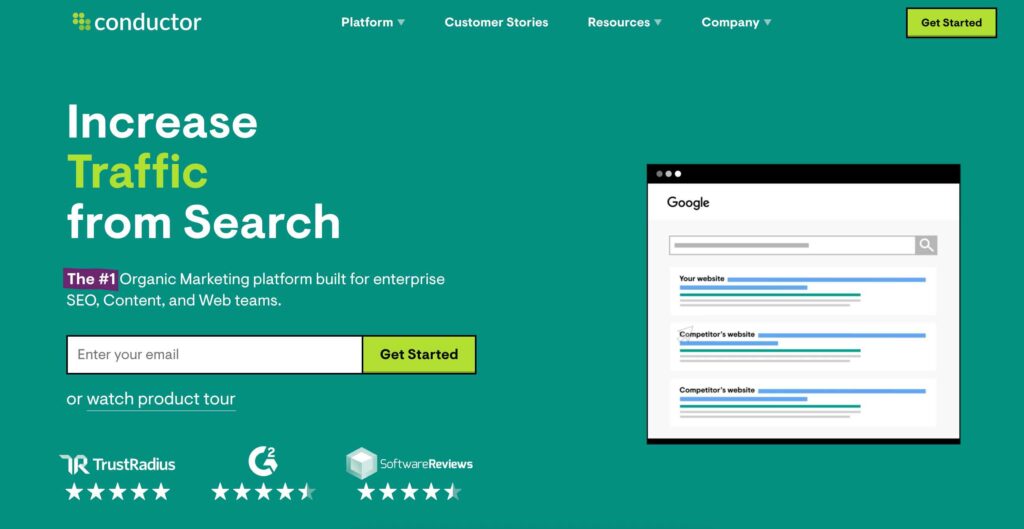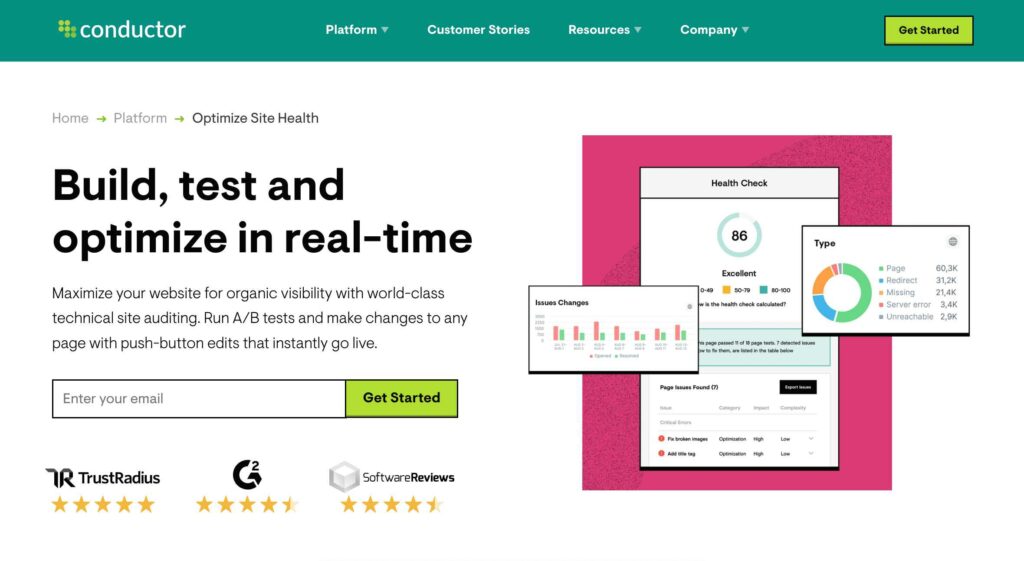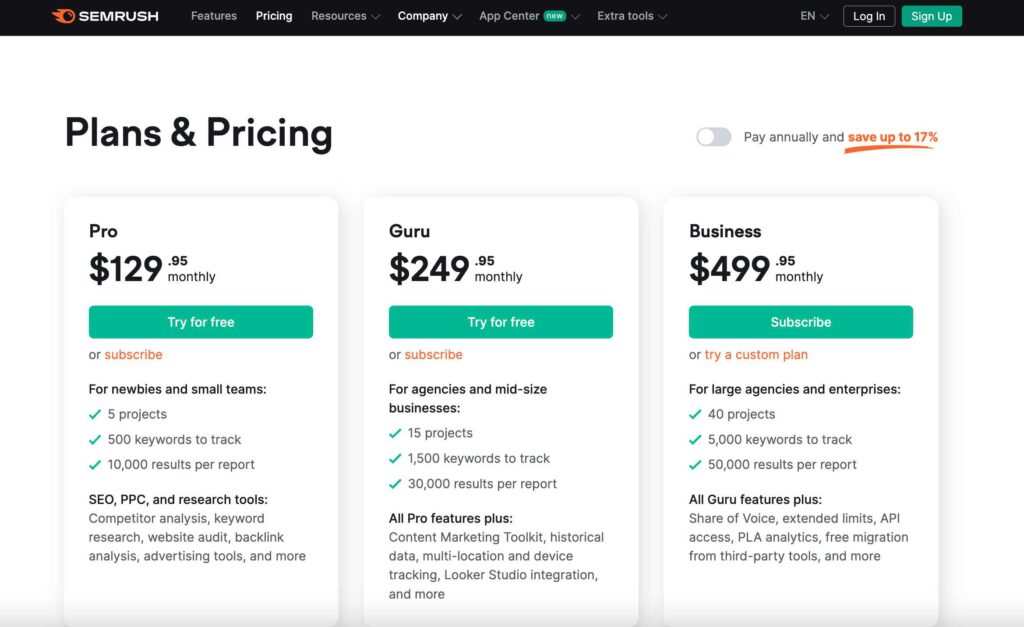Deciding whether Conductor or Semrush is the right keyword ranking and tracking software for your business can be quite a challenge. With so many features and options to consider, it’s easy to feel overwhelmed.
But don’t worry; I’m here to help simplify your decision-making process. Let’s take a closer look at both these tools.
Conductor has an overall score of 9.1, while Semrush scores slightly higher at 9.7. In terms of user satisfaction, Conductor leads with a 100% satisfaction rate, compared to Semrush’s 94%. These numbers give you a quick snapshot of how each tool performs and how other users feel about them.
Remember, the best choice isn’t always the one with the lowest price. It’s about finding the tool that offers the best value for your specific needs.
Think about what your business really needs in terms of keyword tracking and ranking, and then see which of these tools aligns best with those requirements. It’s all about choosing the tool that will help your business grow and succeed in the digital landscape.
So, let’s find out in our Semrush vs Conductor detailed comparison.
Semrush Check out
Check out
|
Conductor Check out
Check out
|
|---|---|
| $129.95 | - |
SEMrush is a digital marketing tool offering SEO, PPC, social media, content marketing, and competitive research features to improve online visibility and marketing insights. |
Conductor is a tool designed for big companies to help them do better in SEO (search engine optimization) and create content that people really like. |
|
|
|
|
|
|
|
It is straightforward, easy-to-use interface, Semrush simplifies navigating through its extensive set of tools and features. |
Conductor maintains a user-friendly interface. It is designed to be intuitive, making it easier for users to find and use various features, which is particularly beneficial for those who may not have advanced technical SEO knowledge. |
|
Semrush offers excellent value for money, with comprehensive SEO tools, market research, and competitor insights, making it ideal for businesses trying to increase their online presence rapidly. |
It does not offer excellent value for money as compared to SEMrush. |
|
SEMrush's knowledge library contains informative articles, and customer support is accessible 24 hours a day, seven days a week by phone, email, and chat. |
Conductor is known for its excellent customer service and instructional tools. Users can access a wide range of training resources, webinars, and tutorials, which is particularly useful for businesses wishing to teach their personnel in SEO and content marketing. |
| Check out | Check out |
Semrush vs Conductor 2025: Overview
Conductor Overview
Conductor is a tool designed for big companies to help them do better in SEO (search engine optimization) and create content that people really like.
It helps businesses make more money by showing them what their customers are looking for so they can create content that really connects with their audience. The platform makes it easy to check your current content and gives tips on how to make it better and more effective.
One of the key features of Conductor is that it lets businesses see what their competitors are doing well. This helps them find new ways to stand out.
The platform also helps with planning and organizing work, predicting how much traffic, money, and new customers you might get, and deciding which tasks are most important for getting better results and making more money.
Plus, Conductor has tools for making reports that you can customize and share with your team, focusing on the things they find most useful and important. This makes it easier for everyone to understand how well your content and SEO strategies are working.
Semrush Overview
Semrush is a popular tool that helps with managing how visible you are online. It’s made to be user-friendly, even though online marketing can be complex.
The tool has a lot of features for SEO (making sure your website shows up in search results), like checking how your ads are doing, researching keywords, looking at backlinks (which are links from other websites to yours), exploring markets, and analyzing website traffic.
What’s cool about Semrush is that it’s really visual. You get graphs and charts that show you all the information you need, and you can easily compare your website with others to see how you’re doing.
It also has a feature for helping you write better SEO content by comparing your content with the top 10 results on Google. This feature helps improve how readable your content is, keeps your brand’s voice consistent, and checks if your content is original.
Semrush isn’t just about SEO; it has over 55 different tools and add-ons for all kinds of online visibility tasks, like social media, market research, and working with Google tools and other management platforms.
It collects data from over 142 countries, monitors over 800 million unique domains, and has over 10 million users. Plus, it has a huge database of 43 trillion backlinks and 21 billion keywords.
All these features make it a powerful tool for anyone wanting to improve their online presence and marketing.
Content Creation: Conductor vs. Semrush
Comparing the content creation and distribution tools offered by Conductor and Semrush reveals distinct approaches and features:
Conductor’s Content Creation Tools:
AI Recommendations: Offers AI-driven recommendations for creating high-performing content, providing a blueprint to guide content development.
Content Optimization: Focuses on uncovering content opportunities with high potential impact, along with real-time SEO recommendations during the writing process.
Actionable Insights: Moves from insights to action by adding recommendations, keywords, and competitor examples to content briefs, which can be integrated with task management tools like Asana, Trello, and Jira.
Technical SEO: Includes live editor features for instant optimizations and advanced on-page SEO testing.
Semrush’s Content Creation and Distribution Tools:
Topic Research: Provides content ideas based on location and topic, revealing rivals’ headlines and audience questions for quality content creation.
Content Marketplace: Offers access to professional copywriters for creating traffic-driving blog posts, optimized as per need.
Social Media Poster: Facilitates sharing content across social channels, with features for scheduling posts and analyzing performance.
Who is the winner?
Focus on AI and Optimization: Conductor emphasizes AI-driven content recommendations and real-time SEO optimizations, making it ideal for businesses focusing on SEO performance and technical content optimization.
Content Ideas and Outsourcing: Semrush provides more extensive support for topic research and outsourced content creation, beneficial for businesses seeking diverse content ideas and professional writing services.
Social Media Integration: Semrush also includes social media management tools, which are advantageous for businesses prioritizing social media content distribution and engagement.
In conclusion, if your primary goal is to enhance SEO performance with AI-driven insights and technical optimizations, Conductor might be the more suitable option.
However, if you are looking for a platform that offers a wider range of topic ideas, access to professional content creation services, and social media management tools, Semrush would be the better choice.
The decision should be based on your specific content creation and distribution needs and the areas you wish to focus on for your business’s online presence.
My Bonus Tip:
Consider combining the strengths of both platforms! Use Conductor for planning, optimization, and tracking, and leverage Semrush for in-depth keyword and topic research.
Remember: The content itself is the ultimate winner. Focus on creating engaging, valuable content that resonates with your audience. The right tool can empower your content creation journey, but your creativity and expertise drive success.
Keyword tracking: Conductor vs. Semrush
Let me compare Conductor and Semrush head-to-head to see who helps you track your keyword ranking performance like a pro.
Conductor:
Rank Tracker: Monitor your keyword rankings across major search engines and locations.
Easy Monitoring: Keep tabs on progress with a simple and clear interface.
Rank Fluctuations: Get notified when your rankings jump or slump, allowing for quick adjustments.
Affordable Option: Offers a competitive price point, ideal for smaller businesses.
Limitations:
Limited Insights: Primarily focuses on rank tracking, and may not offer deeper competitor analysis or keyword research features.
Data Granularity: Might not provide the same level of detailed data and historical trends as Semrush.
Semrush:
Keyword Tracking All-Star: Monitor rankings for a vast number of keywords across search engines, devices, and locations.
Competitor Insights: See how your rivals rank for the same keywords, giving you valuable benchmarking and strategic opportunities.
Keyword Research Powerhouse: Uncover new keyword opportunities and track their potential, fueling your content and SEO strategy.
Historical Trends: Analyze how your rankings have changed over time, identifying patterns and areas for improvement.
Limitations:
Feature Overload: The sheer volume of features can be overwhelming for beginners.
Steeper Learning Curve: Navigating the advanced features might require some technical knowledge.
Premium Price Tag: Costs significantly more than Conductor.
Who Wins the Ranking Race?
It depends on your needs and budget:
For Simple Tracking and Budget-Conscious Racers: Conductor offers a straightforward tracking experience at an affordable price, perfect for keeping tabs on essential keywords.
For Data-Driven Insights and Strategic Champions: Semrush provides comprehensive tracking, competitor analysis, keyword research, and historical trends, ideal for those who want to dominate the race with deep data and strategic planning.
Bonus Tip:
Consider your keyword portfolio size and strategic goals when choosing a tool. A small set of essential keywords might be well-tracked by Conductor, while a larger, complex keyword strategy might require Semrush’s advanced features.
Reporting: Semrush vs Conductor
Conductor Platform:
- Content Measurement:
It focuses on reporting content performance, linking team actions to results with automated content change detection. For instance, Conductor’s Content Performance Report shows you how your content is performing over time, including how it compares to competitors.
- Custom Reporting for Teams:
Offers custom reports for every stakeholder, facilitating Organic Marketing collaboration. For example, you can create custom reports for the marketing team to track the performance of their campaigns, or for the executive team to track the overall site performance.
- Performance Measurement:
Measures content’s impact on traffic, revenue, and SEO KPIs, integrating with web analytics for cross-channel impact.
For example, a performance report for the marketing team might include metrics such as the number of sessions, page views, and conversions associated with each campaign, while an executive report might include metrics such as total traffic, total revenue, and search ranking.
- Action-Result Connection:
Connects actions to results with automatic change detection and custom annotations. This connection enables marketing teams to quickly identify which actions are resulting in successful outcomes, and adjust their strategies accordingly.
- Value-Oriented Reports:
Provides value-oriented reports for stakeholders with customizable templates. For example, the report can be tailored to provide a breakdown of campaigns, ROI, and total sales from a specific date range.
Semrush Platform:
- Report Building:
Allows building professional SEO and marketing reports, either from scratch or using templates. For instance, the report can include data such as organic and paid search traffic, organic and paid keywords, and backlinks.
- Data Integration:
Combines data from multiple sources like Semrush, Google Analytics, Google Search Console, and more for comprehensive reporting.
For example, the report could combine data from Semrush, Google Analytics, Google Search Console, and other data sources to show a breakdown of organic and paid search traffic, organic and paid keywords, and backlinks.
- Report Organization:
Features tools for organizing reports with a user-friendly interface and CRM integration. For instance, users can quickly categorize reports into folders and subfolders for easy navigation and access.
- Data Visualization:
Focuses on turning raw data into clean, understandable reports. This allows users to quickly identify patterns and trends in their data. It also allows them to make better decisions based on data insights.
- White-label Reports:
Offers white-label options for branding, including custom sender names, logos, colors, and more. This allows users to customize the reports they send to their customers, which adds a personal touch and makes them stand out. It also helps them to build better relationships with their customers.
Verdict:
Conductor: Ideal for teams looking for in-depth content performance analysis and the ability to correlate team actions with tangible results. Its automated reporting and custom annotations are beneficial for teams who want to understand the impact of their content strategies.
Semrush: Suited for professionals needing comprehensive, customizable reports combining data from various sources. Its data visualization and white-label features are great for agencies and marketers who need to present branded, professional reports to clients or stakeholders.
Pricing: Semrush vs Conductor
Semrush
Semrush offers three main pricing plans: Pro, Guru, and Business.
- The Pro plan is the most affordable option and is designed for beginners and small teams. It includes 5 projects, 500 keywords, and 500 reports.
- The Guru plan is in the middle tier and is designed for agencies and mid-size businesses. It includes 40 projects, 5,000 keywords, and 5,000 reports.
- The Business plan is the most expensive option and is designed for large agencies and enterprises. It includes 100 projects, 15,000 keywords, and 15,000 reports.
In addition to the number of projects, keywords, and reports, each plan also includes a different set of features. For example, the Pro plan does not include historical data, content marketing tools, or API access, while the Business plan does.
Conductor
Conductor’s pricing details are not disclosed on their website. Instead, their pricing structure depends on factors like the organization’s size and the level of support needed.
This approach can be seen as a disadvantage because potential customers may find it challenging to estimate whether Conductor’s services fit within their budget. While they offer a free demo, not having clear pricing upfront can make it difficult for businesses to plan effectively.
Without knowing the costs, it’s challenging to assess if Conductor’s services align with their financial resources and goals, potentially leading to uncertainty and hesitation in exploring the platform.
Quick Links:
Conclusion: Semrush vs Conductor 2025
In the Conductor vs. SEMrush showdown, both tools have their unique strengths. SEMrush shines with its comprehensive suite of digital marketing features and a user-friendly interface, making it suitable for a wide range of users.
On the other hand, Conductor excels in content recommendations and SEO optimization, with a focus on helping users understand their audience better.
Your choice between the two should align with your specific needs and budget. If you prioritize a one-stop-shop for digital marketing with a bit higher cost, SEMrush might be the way to go.
If you’re more focused on SEO and content performance, Conductor could be your go-to tool. Ultimately, the best choice depends on your specific goals and preferences.






